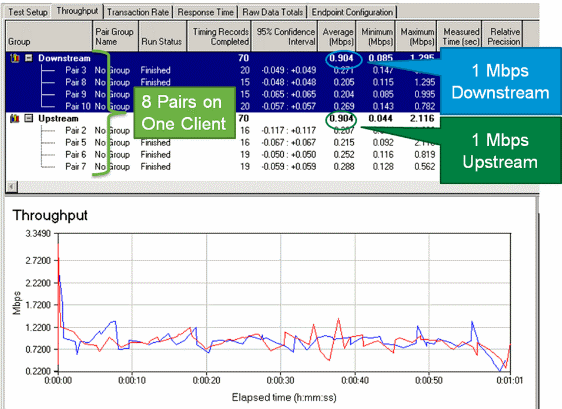Introduction

Providing downstream per-user rate limiting for wireless users is
possible on Cisco Wireless LAN controllers, but the addition of IOS Microflow
policing to the solution allows for granular rate limiting in both the upstream
and downstream directions. The motivation for implementing per-user rate
limiting ranges from bandwidth “hog” protection is to implement tiered
bandwidth models for customer network access, and in some cases, whitelist
particular resources that are exempt from bandwidth policing as a requirement.
In addition to throttling current generation IPv4 traffic, the solution is
capable of per-user IPv6 rate limiting. This provides investment protection.
Prerequisites
Requirements
Microflow policing requires the use of a Supervisor 720 or later that
runs a version of Cisco IOS® Software Release 12.2(14)SX or later.
Components Used
The information in this document is based on these software and
hardware versions:
Conventions
Refer to
Cisco
Technical Tips Conventions for more information on document
conventions.
Catalyst 6500 Configuration
Microflow Policing Configuration
Complete these steps:
-
Utilizing Microflow policing first requires that an access control
list (ACL) be created to identify traffic in order to apply a throttling
policy.
Note: This configuration example uses the 192.168.30.x/24 subnet for
wireless clients.
ip access-list extended acl-wireless-downstream
permit ip any 192.168.30.0 0.0.0.255
ip access-list extended acl-wireless-upstream
permit ip 192.168.30.0 0.0.0.255 any
-
Create a class-map to match on the previous ACL.
class-map match-all class-wireless-downstream
match access-group name acl-wireless-downstream
class-map match-all class-wireless-upstream
match access-group name acl-wireless-upstream
-
Creating a policy-map will link the previously created ACL and
class-map to a distinct action to apply to the traffic. In this case the
traffic is being throttled to 1Mbps in both directions. A source flow mask is
used in the upstream direction (client to AP) and a destination flow mask is
used in the downstream direction (AP to client).
policy-map police-wireless-upstream
class class-wireless-upstream
police flow mask src-only 1m 187500 conform-action transmit exceed-action drop
policy-map police-wireless-downstream
class class-wireless-downstream
police flow mask dest-only 1m 187500 conform-action transmit exceed-action drop
For more information on configuring Microflow policing, refer to
User-Based
Rate Limiting in the Cisco Catalyst 6500.
Adjusting the Bandwidth Policing Policy
The policy statement within the policy-map is where the actual
Bandwidth (configured in bits) and
Burst size (configured in bytes) parameters are
configured.
A good rule of thumb for the burst size is:
Burst = (Bandwidth / 8) * 1.5
Example:
This line uses a rate of 1Mbps (bits):
police flow mask dest-only 1m 187500 conform-action transmit exceed-action drop
This line uses a rate of 5Mbps (bits):
police flow mask dest-only 5mc 937500 conform-action transmit exceed-action drop
Whitelisting Resources from Bandwidth Policing
In some cases, certain network resources should be exempt from
bandwidth policing such as a Windows Update server or posture remediation
appliance. In addition to hosts, whitelisting can also be used to exempt whole
subnets from bandwidth policing.
Example:
This example excludes the host 192.168.20.22 from any bandwidth
limitation when communicating with the 192.168.30.0/24 network.
ip access-list extended acl-wireless-downstream
deny ip host 192.168.20.22 192.168.30.0 0.0.0.255
permit ip any 192.168.30.0 0.0.0.255
ip access-list extended acl-wireless-upstream
deny ip 192.168.30.0 0.0.0.255 host 192.168.20.22
permit ip 192.168.30.0 0.0.0.255 any
IPv6 Microflow Policing

Complete these steps:
-
Add another access list on the Catalyst 6500 to identify IPv6 traffic
to be throttled.
ipv6 access-list aclv6-wireless-downstream
permit ipv6 any 2001:DB8:0:30::/64
!
ipv6 access-list aclv6-wireless-upstream
permit ipv6 2001:DB8:0:30::/64 any
-
Modify the class-map to include the IPv6 ACL.
class-map match-any class-wireless-downstream
match access-group name aclv6-wireless-downstream
match access-group name acl-wireless-downstream
class-map match-any class-wireless-upstream
match access-group name aclv6-wireless-upstream
match access-group name acl-wireless-upstream
Appliance-based (2500, 4400, 5500) Controller Configuration
In order to provide Microflow policing with an appliance-based
controller, such as the 5508 series, the configuration is simplistic. The
controller interface is configured similar to any other VLAN, while the
Catalyst 6500 service policy is applied to the controller
interface.

Complete these steps:
-
Apply police-wireless-upstream on the
incoming port from the controller.
interface GigabitEthernet4/13
description WLC
switchport
switchport trunk allowed vlan 30
switchport mode trunk
service-policy input police-wireless-upstream
end
-
Apply policy-wireless-downstream on
the uplink LAN/WAN ports.
interface GigabitEthernet4/20
description WAN
switchport
switchport access vlan 20
switchport mode access
service-policy input police-wireless-downstream
end
Module-based (WiSM, WiSM2) Controller Configuration
In order to leverage Microflow policing on the Catalyst 6500 with the
Wireless Service Module2 (WiSM2), the configuration must be adjusted to use
VLAN-based Quality of Service (QoS). This means that the Microflow policing
policy is not applied directly to the port interface (for example, Gi1/0/1),
but is applied on the VLAN interface.

Complete these steps:
-
Configure the WiSM for VLAN-based QoS:
wism service-vlan 800
wism module 1 controller 1 allowed-vlan 30
wism module 1 controller 1 qos vlan-based
-
Apply policy-wireless-upstream on
Client VLAN SVI:
interface Vlan30
description Client-Limited
ip address 192.168.30.1 255.255.255.0
ipv6 address 2001:DB8:0:30::1/64
ipv6 enable
service-policy input police-wireless-upstream
end
-
Apply policy-wireless-downstream on
the uplink LAN/WAN ports.
interface GigabitEthernet4/20
description WAN
switchport
switchport access vlan 20
switchport mode access
service-policy input police-wireless-downstream
end
Solution Verification
One of the main requirements of per-user rate limiting is the ability
to limit all flows coming from and destined to a particular user. In order to
verify that the Microflow policing solution meets this requirement, IxChariot
is used to simulate four simultaneous download sessions and four simultaneous
upload sessions for a particular user. This can represent someone launching a
FTP session, browsing the web and watching a video stream while sending an
email with a large attachment, etc.
In this test IxChariot is configured with the “Throughput.scr” script
using TCP traffic in order to measure the speed of the link using throttled
traffic. The Microflow policing solution is able to throttle all streams down
to a total of 1Mbps downstream and 1Mbps upstream for the user. In addition,
all of the streams use roughly 25% of available bandwidth (for example, 250kbps
per stream x 4 = 1Mbps).

Note: Because the Microflow policing action occurs at Layer 3, the end
result for TCP traffic throughput can be less than the configured rate because
of protocol overhead.
Related Information






 Feedback
Feedback